Battles - The Battle of Verdun, 1916
 The German siege of Verdun and its ring of forts, which comprised the longest battle of the First World War, has its roots in a letter sent by the German Chief of Staff, Erich von Falkenhayn, to the Kaiser, Wilhelm II, on Christmas Day 1915.
The German siege of Verdun and its ring of forts, which comprised the longest battle of the First World War, has its roots in a letter sent by the German Chief of Staff, Erich von Falkenhayn, to the Kaiser, Wilhelm II, on Christmas Day 1915.
In his letter to the Kaiser, Falkenhayn argued that the key to winning the war lay not on the Eastern Front, against Russia - whom he believed was on the point of revolution and subsequent withdrawal from the war - but on the Western Front. He reasoned that if France could be defeated in a major set-piece battle Britain would in all likelihood seek terms with Germany, or else be defeated in turn.
In his letter to Wilhelm Falkenhayn believed that Britain formed the foundation of the Allied effort ranged against Germany and that she must be removed from the war. To that end he recommended implementation of a policy of unrestricted submarine warfare against merchant shipping, a policy directed squarely at starving Britain. This combined with a knock-out block to France would, he believed, bring about a successful conclusion to hostilities.
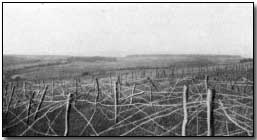 The
Kaiser acted upon Falkenhayn's recommendations, agreeing to the policy of
unrestricted submarine warfare, dangerous as it was in running the risk of
bringing the U.S. into the war. He also sanctioned implementation of a
set-piece siege against Verdun, Falkenhayn's choice of French target,
starting in February 1916.
The
Kaiser acted upon Falkenhayn's recommendations, agreeing to the policy of
unrestricted submarine warfare, dangerous as it was in running the risk of
bringing the U.S. into the war. He also sanctioned implementation of a
set-piece siege against Verdun, Falkenhayn's choice of French target,
starting in February 1916.
In so doing he agreed to switch focus from the Eastern Front to the Western Front. This latter strategy was not without its critics: in particular Paul von Hindenburg argued that the opportunity was lost to capture the bulk of the Russian army. Ultimately the failure of Falkenhayn's recommendations cost him his position.
Falkenhayn's choice of Verdun as the focus of the German offensive was shrewd. Although relegated by France to the status of a minor fortress during the early stages of the war, France having lost faith in the value of fortress defences, Verdun maintained a great psychological hold in the minds of the French people. On a practical level the woods immediately behind Verdun would have proved far easier to defend than the Verdun forts.
The last fortress town to fall to the Prussians in the Franco-Prussian war of 1870-71, Verdun's fortifications had been significantly boosted in the 1880s to withstand further attacks. In addition its status as an important fortress since Roman times guaranteed recognition of the name ‘Verdun' to most Frenchmen. In short, it was of greater value symbolically than strategically. Falkenhayn counted upon this.
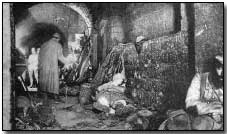 His
plan was to subject Verdun to intense bombardment, thus drawing in and
diverting French troops from all over the Western Front to the eight mile
wide front around Verdun.
His
plan was to subject Verdun to intense bombardment, thus drawing in and
diverting French troops from all over the Western Front to the eight mile
wide front around Verdun.
Falkenhayn's stated aim was to "bleed France white" in its defence of the ancient fortress town. The fact that Verdun formed a French salient into German lines only served to help Falkenhayn, since it meant that it was open to attack from three sides at once.
The task of besieging Verdun fell to the German Fifth Army under Crown Prince Wilhelm. He planned to assault the town from both side of the surrounding Meuse River, a plan vetoed by Falkenhayn, who, cautious by nature, feared heavy losses, ordered the attack to be confined to the east bank of the river.
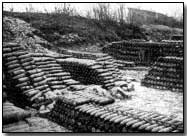 Originally scheduled to start on 12 February the offensive was postponed to
21 February on account of poor weather, preceded by a 21 hour
preliminary
bombardment.
Originally scheduled to start on 12 February the offensive was postponed to
21 February on account of poor weather, preceded by a 21 hour
preliminary
bombardment.
In the interim between the planned and actual start date French Commander-in-Chief Joffre received intelligence of the imminent attack, hastily deploying reinforcements to the French Second Army. Meanwhile the fortress commander, Lieutenant Colonel Emile Driant, also a politician and published author, vainly attempted to improve Verdun's trench systems in time.
Driant prepared for the onslaught by posting two battalions, led by himself, at the tip of the Verdun salient on the east bank of the Meuse River. He faced formidable opposition: one million German troops against 200,000 defenders.
The attack finally began at 07:15 on 21 February, Crown Prince Wilhelm opening the battle with 1,400 guns packed along the eight-mile front, the guns well served by good nearby railway facilities. 100,000 shells poured into Verdun every hour, Wilhelm's intention being to kill the majority of the French defenders before the infantry even started their advance into the fortress.
An optimistic assessment, a German scouting party sent in following the initial bombardment later that day reported half of the French fighting force remained to meet the planned attack.
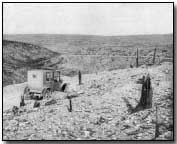 It
is arguable that had Wilhelm chosen to attack at this point the fortress
might still have been taken. Instead, daunted by the apparently
formidable defences, Wilhelm chose to renew the bombardment.
It
is arguable that had Wilhelm chosen to attack at this point the fortress
might still have been taken. Instead, daunted by the apparently
formidable defences, Wilhelm chose to renew the bombardment.
By the close of the day the German forces had succeeded only in capturing the French front line trenches, much less than planned, although Driant himself had been killed during the battle, and his two battalions demolished.
Wilhelm withdrew his forward infantry in preparation for a further artillery bombardment, thus taking the sting out of the momentum that had been generated. More importantly it allowed the French defenders to position themselves such that they were able to enfilade the advancing German troops from across the river.
Verdun remained in French hands, although the defensive situation was dire. A message was sent to French headquarters on 23 February reporting that Driant had been lost, as had all company commanders, and that the battalion had been reduced from 600 to around 180 men.
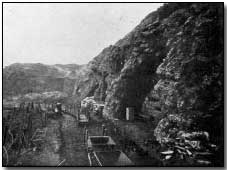 The
following day, 24 February, German troops succeeded in over-running the
French second line of trenches, forcing the defenders to within 8 kilometres
of Verdun itself. Nevertheless, two outer forts, Vaux and Douaumont,
continued to hold out.
The
following day, 24 February, German troops succeeded in over-running the
French second line of trenches, forcing the defenders to within 8 kilometres
of Verdun itself. Nevertheless, two outer forts, Vaux and Douaumont,
continued to hold out.
A French division sent in piecemeal that same day was dispersed under heavy German artillery fire. The next day Douaumont fell to the 24th Brandenburg Infantry Regiment. The effect on French morale of the loss of Douaumont was marked, both upon the remaining defenders and the reinforcements freshly arrived. Popular French sentiment within the country demanded its recapture: withdrawal from Verdun was therefore politically impossible.
The French Commander-in-Chief, Joffre, remained unflappable. He issued a statement noting that any commander who gave ground to the advancing Germans would be court-martialled. He summarily dismissed General Langle de Cary, who was responsible for the defence of Verdun, for deciding to evacuate Woevre plain and the east bank of the Meuse River.
In Langle de Cary's place Joffre promoted Henri-Philippe Petain, a talented officer whose progress through the French army had been slowed on account of his defiance of the prevailing motto of ‘attack at all costs', believing that this was a recipe for disaster, defensive technology being so much greater advanced than offensive technology.
Nevertheless, his own imperturbability in the face of adversity, somewhat similar to Joffre's, had led to his advancement to command of the French Second Army by the time he was appointed to the defence of Verdun.
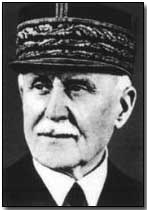 Pledging to Joffre, "Ils ne passeront pas!" - literally "They shall not pass!" - Petain telephoned the commander of the Verdun front line and
instructed him to hold fast. In a sense Petain's appointment could hardly
have better-suited Falkenhayn.
Pledging to Joffre, "Ils ne passeront pas!" - literally "They shall not pass!" - Petain telephoned the commander of the Verdun front line and
instructed him to hold fast. In a sense Petain's appointment could hardly
have better-suited Falkenhayn.
His stated aim of the campaign was to bleed the French army at Verdun. A quick German victory at Verdun would hardly meet this criteria, whereas Petain's dogged determination to hold out suited his intentions perfectly. However he could hardly have determined just how effective Petain's defensive strategies turned out to be.
Petain understood that the defence of Verdun would result in many French casualties: the nature of the terrain made this inevitable. However he was determined to inflict the maximum damage to the German invaders in the course of these losses. Hence he effectively re-organised French use of artillery, personally taking commanding of this aspect of the defence.
He also took action to ensure that an effective supply route to Verdun was maintained, designating a single artery road leading to a depot 50 miles to the west, Bar-le-Duc, and ensuring constant access by assigning columns of troops whose sole duty it was to maintain clearance of the road and to perform repairs as necessary. The road was christened ‘Voie Sacree' - the 'Sacred Road'.
 On 6
March the Germans began a fresh offensive after receiving fresh artillery
supplies, at first making great progress until French counter-attacks pushed
back the advancing German infantry.
On 6
March the Germans began a fresh offensive after receiving fresh artillery
supplies, at first making great progress until French counter-attacks pushed
back the advancing German infantry.
For the remainder of the month Wilhelm launched repeated attacks against the French reinforcements constantly pouring into the fortress. Of the 330 infantry regiment of the French army, 259 eventually fought at Verdun.
Falkenhayn reluctantly committed another corps of men to an attack up the left bank of the Meuse River towards a small ridge named Le Morte-homme (the 'Dead Man'), a battle that raged continuously without conclusion.
Meanwhile the casualties were mounting rapidly on both sides. The French were certainly losing huge numbers of men, as were their German opposition. By the time the battle ended almost one million casualties had been incurred in roughly equal numbers on either side.
April 9 saw the third major German offensive launched, this time on both sides of the salient. Again Petain's defences held, the attacks and counter-attacks continuing until the close of May, the German forces inching ever closer to the remaining forts. During this period Petain received a promotion and was replaced at Verdun by the aggressive Robert Nivelle.
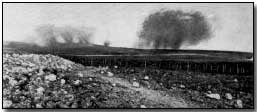 Mort Homme Hill was secured by the Germans on 29 May and finally, on 7 June, Fort Vaux fell.
Mort Homme Hill was secured by the Germans on 29 May and finally, on 7 June, Fort Vaux fell.
Situated on the east bank of the Meuse River, the fort had held out against constant bombardment since the start of the battle in February. However, by now out of reserves of water and the fort itself lying in ruins, its French defenders could hold out no longer. With the capture of the fort Wilhelm offered his congratulations to the fort commander, Major Raynal, for holding out so long.
Encouraged by the success in capturing Fort Vaux, German troops almost succeeded in breaking through the French line at the close of June and into early July. It was at this stage that the latest form of chemical warfare was unveiled by Germany: phosgene gas, which acted by forming as hydrochloric acid once inhaled into the lungs.
Joffre, meanwhile, pressed the British government to stage a major diversionary offensive elsewhere on the Western Front to serve as a drain on German manpower. Originally scheduled for 1 August, the Battle of the Somme was brought forward to 1 July upon the insistence of the French.
Petain, against Nivelle's recommendation, recommended a withdrawal from the western Meuse line. Joffre, however, supported Nivelle in dismissing the suggestion, a decision that was fortunately vindicated by a sudden drain upon German resources as a result of a Russian offensive on the Eastern Front, which meant that fifteen German divisions had to be withdrawn from Verdun to aid in the defence on the east.
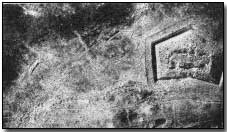 By
this stage the German Chancellor,
Theobald von Bethmann-Hollweg, was
scathing in his condemnation of Falkenhayn's lack of success in Verdun,
which was proving as costly in terms of manpower to Germany as it was to
France. Falkenhayn was consequently dismissed by the Kaiser and dispatched
to the Transylvanian Front on 29 August to command Ninth Army. Falkenhayn's
arch critic, Paul von Hindenburg, replaced him as Chief of Staff, buoyed by
his successes in the east.
By
this stage the German Chancellor,
Theobald von Bethmann-Hollweg, was
scathing in his condemnation of Falkenhayn's lack of success in Verdun,
which was proving as costly in terms of manpower to Germany as it was to
France. Falkenhayn was consequently dismissed by the Kaiser and dispatched
to the Transylvanian Front on 29 August to command Ninth Army. Falkenhayn's
arch critic, Paul von Hindenburg, replaced him as Chief of Staff, buoyed by
his successes in the east.
A new French commander of the Verdun forts, Third Army's General Charles Mangin, was also appointed, reporting to Nivelle. Taking the offensive Mangin managed to retake Douaumont on 24 October, followed by Fort Vaux on 2 November. Following a rest pause, Mangin renewed his offensive, retaking ground lost since the start of the German attack. Between 15-18 December alone, when the battle ended, the French captured 11,000 prisoners and with them 115 heavy guns. Simply put, Hindenburg saw no point in continuing Falkenhayn's pointless attacks.
French casualties during the battle were estimated at 550,000 with German losses set at 434,000, half of the total being fatalities. The only real effect of the battle was the irrevocable wounding of both armies. No tactical or strategic advantage had been gained by either side.
Click here to view a map detailing the progress of the battle
Click here to read Erich von Falkenhayn's justification for the Verdun offensive. Click here to read Crown Prince Wilhelm's summary. Click here to read Wilhelm's summary of its abandonment. Click here to read von Hindenburg's decision to call off the offensive. Click here to read Erich Ludendorff's dismissive view of the battle. Click here to read Joffre's August 1916 summary of the battle. Click here to read British newspaper baron Lord Northcliffe's despatch during the early days of the battle. Click here to read a French memoir of the German attack on Le Mort Homme in May 1916. Click here for a memoir of the struggle for Fort Douaumont the same month. Click here for a memoir of the German assault upon Fort Vaux in June 1916. Click here to read General Millerand's official account of the see-saw fighting at Thiaumont in July and August 1916. Click here to read a semi-official German historian's account of the end of the battle. Click here to read General von Zwehl's memorandum issued immediately before the French recapture of Forts Vaux and Douaumont. Click here to read Ludendorff's statement regarding the loss of Forts Vaux and Douaumont. Click here to read French General Pierre Dubois's view of the German approach at Verdun. Click here to read a French staff officer's account of the recapture of Fort Douaumont in October 1916.
Photographs courtesy of Photos of the Great War website
A 'flying pig' was a mortar bomb.
- Did you know?
